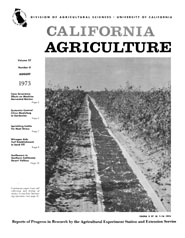


University of California
California Agriculture
|
|||
|
|||

Cover:
Continuous puper trays aid collecting and drying of raisins in machine harvesting
operation.
August 1973
Volume 27, Number 8 News and opinion |
|||
|
University of California, 1301 S. 46th St., Bldg. 478 Richmond, CA
|